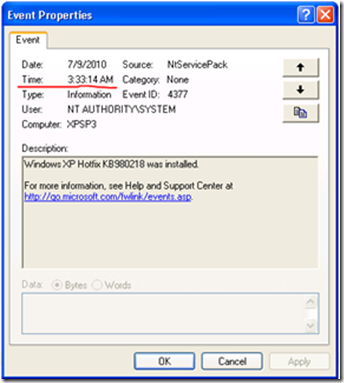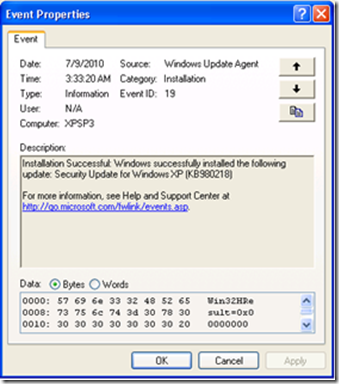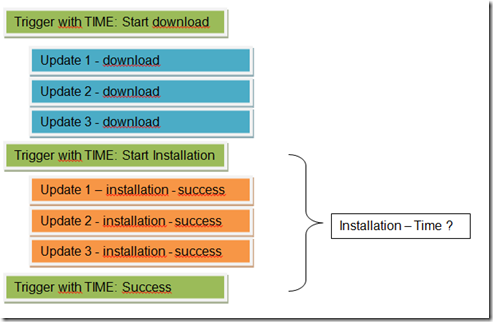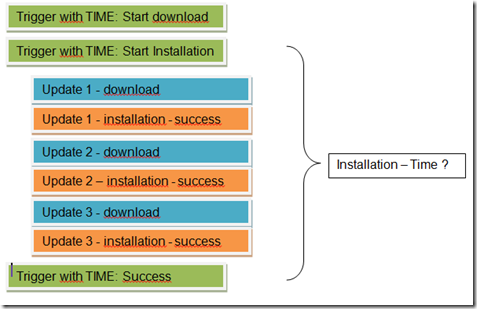How to Measure Update Installation Time
Challenges When Measuring Update Installation Time
In order to measure the time needed to install all necessary updates, an administrator needs to know the following information:
1. How many updates will be installed?
2. When have the update installations been started?
3. Is there additional time needed for downloading the update?
4. How long does it take to install specific updates?
5. How can I see that an Update has been installed?
These questions will be discussed in the following chapters. Additionally it will be shown, whether these factors can be measured using a KPI and how.
How many updates will be installed?
The number of updates that are applicable for a Windows XP machine is growing with every month. Each month on patch Tuesday, additional around 3-12 Updates are being released for Windows XP and its components. This means that the number of updates and thus the installation time is increasing with every month. If known updates are being applied to the base image, this number of updates on the other hand is decreasing.
In order to measure the update installation time using a KPI the measuring tool would need to have the information, when the last update of the installation chain has been reached. Also, the reference numbers for measurement have to be adjusted every time an update is added (new update) or removed (update added to base image).
When have the update installations been started?
The start of an update installation process can be triggered by many different tools. If the windows update Agent starts the update installation, a matching start-string is published to the windowsupdate.log. If any other tool starts off the installation, this information may or may not appear in some log file. In any case the beginning of an update installation is not published to the windows event viewer. Only the successful installation is published.
In order to measure the update installation time using a KPI, the start information of the update installation would have to be published by the tool, which triggers the installation. This information is not provided by windows.
Is there additional time needed for downloading the update?
Update, that have to be applied on a system have to be downloaded first normally. If the Windows client is connected to a windows update service, the clients need to download the updates using BITS. If the client is installing the update directly from a share or distribution point (SCCM), the downloads will happen using SMB. The download time of the update is dependent on the following factors:
- Download technology (BITS / SMB)
- Connection Performance (LAN / VPN)
- Update sizes
- Number of updates
- User interference (download disruption, removed cable, hibernating or sleeping clients, unstable wireless connection, unstable UMTS connection etc…)
In order to measure the update installation time using a KPI, the measuring system needs to be aware of these factors that strongly impact the download time.
How long does it take to install specific updates?
Most of the monthly security updates commit a minor change to Windows or the Internet Explorer. Mostly, a dll is getting replaced or some functions are changed or blocked (for example activeX killbits). However, some update commit major changes to the system like installing or changing several updates, fixing .net settings or even updating whole components like .net service pack or a new version of IE. For security reasons, Microsoft will not publish the information on what exactly is changed within an update and what not. It’s fact that every update has a different installation time, because they are committing different changes to the OS or some other component. Additionally, the client’s hardware performance (CPU, Disk), the user behavior (disruption, hibernation, working whilst installing updates,…) and the system configuration (more software installed means longer installation time due to the applicability scanning) impacts the update installation time.
In order to measure the update installation time using a KPI, the measuring system needs to be aware of these factors that strongly impact the installation time.
How can I see that an Update has been installed?
The Bulletin Installation is visible with timestamp within the EventVWR:
If the update has been installed using the windowsupdate agent, the installation succession event is also visible within the event log:
Additionally, on windows XP, a log file with the name of the knowledge base article is created under %windir%:
IF the update was installed using the WindowsUpdate agent, the update will also be shown within the Windows-Update.log:
2010-06-23 01:35:29:373 3280 2a4 Handler :::::::::::::
2010-06-23 01:35:29:373 3280 2a4 Handler :: START :: Handler: Windows Patch Install
2010-06-23 01:35:29:373 3280 2a4 Handler :::::::::
2010-06-23 01:35:29:373 3280 2a4 Handler : Updates to install = 1
2010-06-23 01:35:29:373 3280 2a4 Handler : Installing update {E8714A48-2007-48F5-B7BF-2F33E0C81EDA}.102
2010-06-23 01:35:29:383 3280 e44 Handler Installing with parameters=-q -z -er, sandbox=C:\WINDOWS\SoftwareDistribution\Download\a4c07d9275eb613d842cb1e140d8a426.
2010-06-23 01:35:34:370 896 ba8 Report REPORT EVENT: {A685CFA7-61E7-481D-9734-D54ADF55703D} 2010-06-23 01:35:29:363-0700 1 184 101 {23491AFE-537E-4684-9D10-895516D6FAE7} 104 0 WindowsUpdate Success Content Install Installation successful and restart required for the following update: Security Update for Windows XP (KB980218)
2010-06-23 01:35:36:422 3280 e44 Handler Install completed with 0x0.
2010-06-23 01:35:36:422 3280 2a4 Handler : Install completed: result type = 0x1, installer error = False, error = 0x0, disabled until reboot = No, reboot required = No
2010-06-23 01:35:36:422 3280 2a4 Handler :::::::::
2010-06-23 01:35:36:422 3280 2a4 Handler :: END :: Handler: Windows Patch Install
2010-06-23 01:35:36:422 3280 2a4 Handler :::::::::::::
Opportunities When Measuring The Update Installation Time
Setting Timestamps Using Chained Tasks
In order to measure the update installation time, a chain of tasks would be needed containing a task running right before the update installation and a task running right after the update installation. This chain of tasks would also have to trigger the update installation and collect the installation success messages.
Such a chain of tasks could look like this: (Model 1)
Or like this (Model 2)
Microsoft System Center Configuration Manager supports using such chained tasks by providing the tool “task sequencer”.
Defining a Key Performance Indicator
Summarizing, the update installation time is dependent on the
· number of updates (changes every month)
· installation time of different updates (different on any update)
· download and installation performance
Since it is not possible to exactly predict all of these dependencies, a update installation time key performance indicator would have to be set very broad to allow a lot room for change. Thus, it’s unsure whether a KPI in this case makes sense at all.




